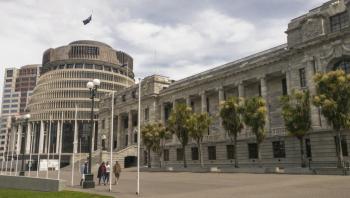Programme overview
Applications for this programme have closed for 2025.
The Bachelor of Health Science (Medical Imaging) provides you with the clinical and theoretical knowledge to work as a registered medical imaging technologist (MIT). To safely obtain images using radiation for diagnostic use, you need a sound understanding of anatomy, physiology, pathology, physics, and the medical radiation equipment and clinical techniques you will use in the industry. We'll help you develop these skills so you complete your degree confident and work-ready. You'll also get an introduction to more advanced imaging systems.
Highlights
- At Unitec, we think the best way to learn is a mixture of thinking and doing. You'll spend over 2000 hours (in block periods of time) across all three years of your degree gaining clinical experience working in a radiology/x-ray department, as well as developing your medical knowledge so you can easily transition to the workplace. Our staff will help you find suitable clinical placements, which may be in Auckland, as well as other regional centres throughout New Zealand.
- Accredited by the New Zealand Medical Radiation Technologists Board (MRTB).
- Leads to industry registration: once you've completed this programme you can apply for registration with the New Zealand Medical Radiation Technologists Board (MRTB).
- This programme is an internationally recognised qualification.
- Highly qualified teaching staff with extensive first-hand experience of clinical provision and discipline need.
Clinical placements
This programme includes over 2000 hours of work experience via clinical placements.
- Year 1: 1 x 12-week block
- Year 2: 2 x 10-week blocks
- Year 3: 2 x 10-week blocks
Accommodation and travel are not included as part of your fees, therefore you'll need to cover all costs associated with these (if necessary) in order to attend the clinic to which you have been assigned.
Overseas Registration
Once you've graduated, you'll have the option of pursuing a career in New Zealand or overseas. If you want to work overseas as a qualified MIT, each country's registration body has its own system of determining eligibility. However, they all require hard copies of your course descriptors signed by the Academic Programme manager. There is an administration charge for requesting these. Please complete the request form below to initiate this process.
Admission requirements
What you will need to study this programme.
Domestic students
International students
Academic requirements
Applicants must be at least 16 years of age when they begin their studies, and they should meet the country-specific admission requirement or have completed one of the following:
And English entry requirements;
If English is not your first language, you will also need at least one of the following qualifications:
- IELTS (Academic) with an overall score of 6.5 with no band score lower than 6.0 in speaking, reading, writing, and listening – we have an IELTS Preparation short course available, as well as an IELTS test center on-campus;
- A TOEFL score of 575; or
- University Entrance Literacy: 8 credits at Level 2 or above in English or Māori (4 in Reading, 4 in Writing); or
- Evidence of English language proficiency as outlined in the NZQA Rules on the Unitec English Language Requirements for International Students Web-page.
Don’t meet these Academic requirements?
- If you don’t meet the academic criteria, our Bridging Education Programmes and English Language programmes available can help you qualify. Apply online, and we’ll be in touch about your next steps.
- If you don’t meet the above criteria, special or discretionary admission may apply; your eligibility will be determined at the interview.
Non-academic requirements
- Be at least 17 years old by the time the programme begins;
- Be able to participate in all clinical aspects of the programme;
- Complete a self-declaration of criminal convictions and medical conditions form;
- Consent to a Safety Check that meets the requirements of the Children Act 2014 (formerly known as the Vulnerable Children's Act), including:
- Provide two forms of ID and evidence of any name changes;
- Consent to a police vet check;
- Provide the names of two referees whom Unitec or your placement provider can contact;
- If required, participate in an interview;
- If required, provide a chronological summary of your work history for the past 5 years and the names of any professional organisations, licensing authorities, and registration authorities you have been or are a member of.
For more information, download the full programme regulations (PDF, 505KB).
Courses and timetables
For more details on the courses including timetables, please click on the course names below.
| Courses | Credits | Aim |
|---|---|---|
| Clinical Practice 1 (HEAL5250) | 15 credits (0.125 EFTS) | To enable students to demonstrate the specified clinical competency required within a clinical environment. |
| Structural Osteology and Arthrology (HEAL5251) | 15 credits (0.125 EFTS) | To investigate the structure, function and development of the human skeletal system. |
| Imaging Science I (HEAL5253) | 15.0 credits (0.125 EFTS) | To develop an introductory understanding of the technical & physical principles that underpin contemporary practices of medical image capture, processing, manipulation, display and archival storage. |
| Professional Practice I (HEAL5254) | 15.0 credits (0.125 EFTS) | To develop an understanding of professional ethics and personal responsibilities, patient care and management, and communication within a health care environment. |
| Radiation Physics (HEAL5255) | 15.0 credits (0.125 EFTS) | To develop an understanding of the rationale and application of the physical concepts relevant to medical imaging. |
| Radiographic Imaging I (HEAL5256) | 15.0 credits (0.125 EFTS) | To investigate a range of routine and supplementary radiographic examinations. |
| Anatomy and Physiology (HEAL5421) | 15.0 credits (0.125 EFTS) | This course is designed to provide students with a foundational understanding of anatomy and physiology of body systems as they relate to medical imaging practice. |




